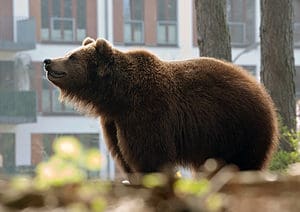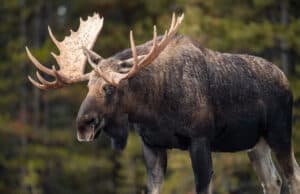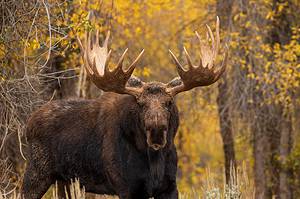In nature, it is always fascinating to see wild animals. If you can’t see them, you can still find clues of their presence. Whether you are hiking in the woods, snowshoeing through powder, or trudging across muddy riverbeds, you may want to keep an eye out for animal tracks. Being able to identify animal tracks can paint an interesting picture of the animals that have passed through, even if you missed seeing them for yourself. Animal tracks are also important for locating and hunting animals. This article will focus on moose tracks – where you might find them, why they look the way they do, and what they look like in different ground conditions. Read on for the complete guide on moose track identification.
| Characterisitic | Description |
|---|---|
| Size | 4 1/2 to 7 inches long 3 to 5 inches wide |
| Shape | Heart or teardrop shape with point at front end |
| Toe Number | 2 hooved toes |
| Other Features | 2 dewclaws |
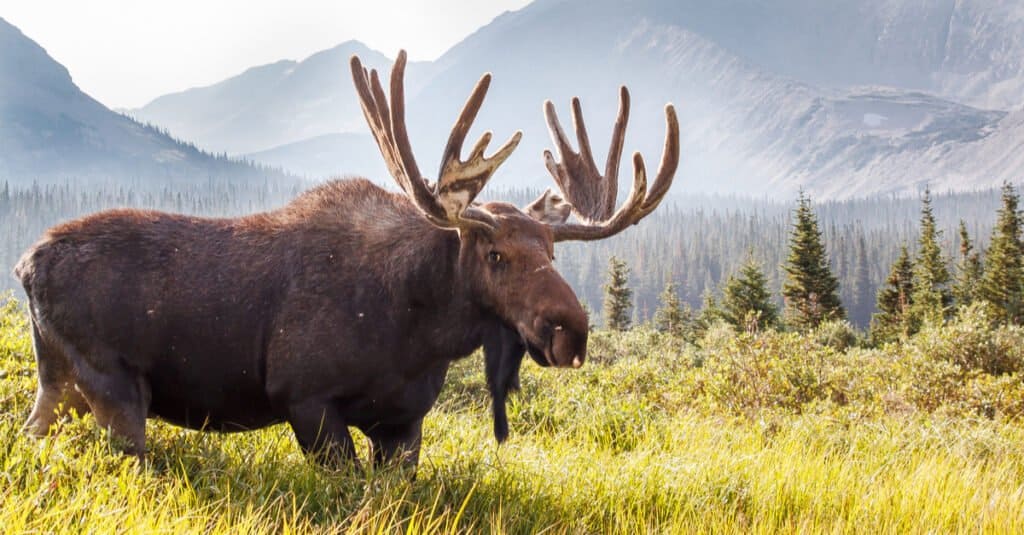
Moose are the largest species of deer and have the largest tracks to match.
©Michael Liggett/Shutterstock.com
Animal Background
Description
Moose are the largest living members of the deer family. A male moose, a bull, typically weighs between 838 to 1,543 pounds. A female moose, a cow, weighs between 441 to 1,080 pounds. Moose stand between 4 feet 7 inches and 6 feet 11 inches tall at the shoulder. The largest moose on record was a bull weighing 1,808 pounds and standing 7 feet 8 inches tall at the shoulder! The moose is the second largest land animal in North America, surpassed only by the American bison.
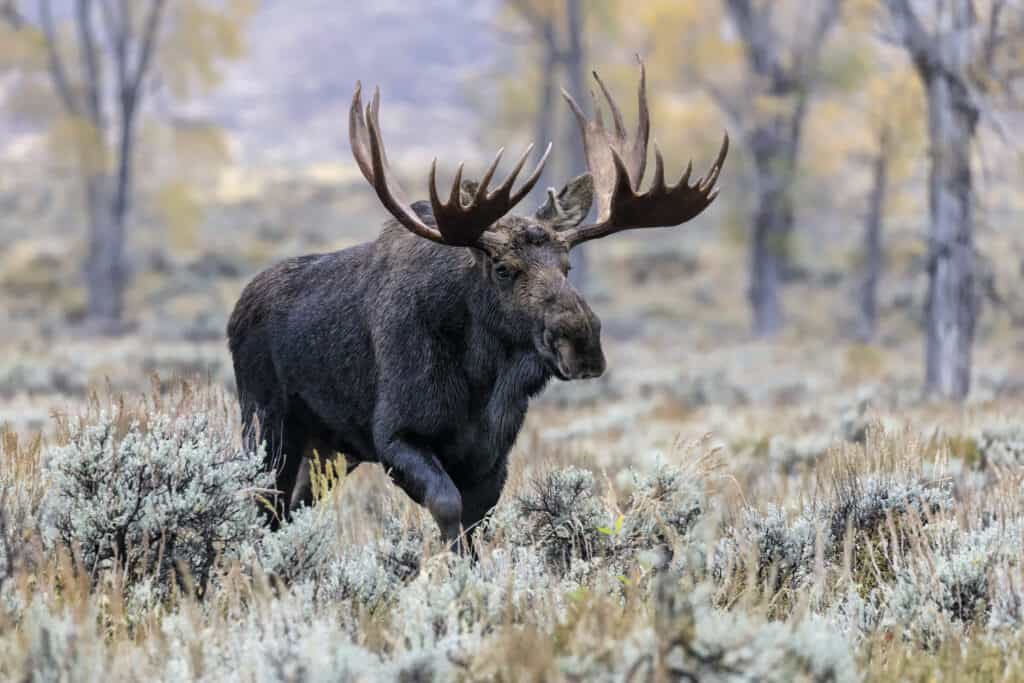
Moose are very heavy and as a result, they often leave clear hoof impressions on soft ground.
©David Osborn/Shutterstock.com
Moose are a type of ungulate. Ungulates are large mammals with hooves and are grouped into odd-toed and even-toed ungulates. Moose are even-toed ungulates that bear their weight on two hooved toes. Others in this group are giraffes, pigs, hippopotamuses, llamas, sheep, and many more.
Distribution
Before we learn how to identify moose tracks, let’s first learn where we might find them. In North America, moose live in Canada and northern regions of the United States. States with moose populations include Alaska, Massachusetts, New Hampshire, Rhode Island, Vermont, New York State, Montana, Idaho, Wyoming, Colorado, Minnesota, and Michigan. Other northern states have small populations as well. Of the lower 48 states, Maine has the largest number of moose. In Eurasia, moose live in Norway, Sweden, Finland, Russia, the Baltic states (Estonia, Latvia, and Lithuania), Poland, northern Ukraine, and Kazakhstan.

When moose are hot, they immerse themselves in water. You may find moose tracks near lakes in the spring and summer.
©Pierre Leclerc/Shutterstock.com
Moose are adapted to the cold habitats of the Northern Hemisphere. They live in areas with consistent or frequent snow but avoid areas of deep snow that might impair mobility. Barren habitats, like the Arctic, although cold are not suitable for moose because of insufficient food resources. In hot weather, moose often retreat to cooler, wet habitats like lakes or ponds where they can immerse themselves to regulate their body heat. Therefore, moose and the tracks they leave behind will most often be found in snowy habitats or near bodies of water.
Moose Tracks
Moose Hoof Morphology
A hoof is the tip of an ungulate’s toe. Hooves are thick, hard structures that grow continuously throughout an animal’s life. Moose have two large hooves on each foot that splay under the weight of the animal. This increases surface area and is beneficial when walking on soft surfaces like snow and mud. In addition to the two large hooves, a moose track may also include impressions from two small dewclaws. Dewclaws are small digits located posterior to the hooves. These digits do not serve a major function but can appear in tracks depending on the ground covering.
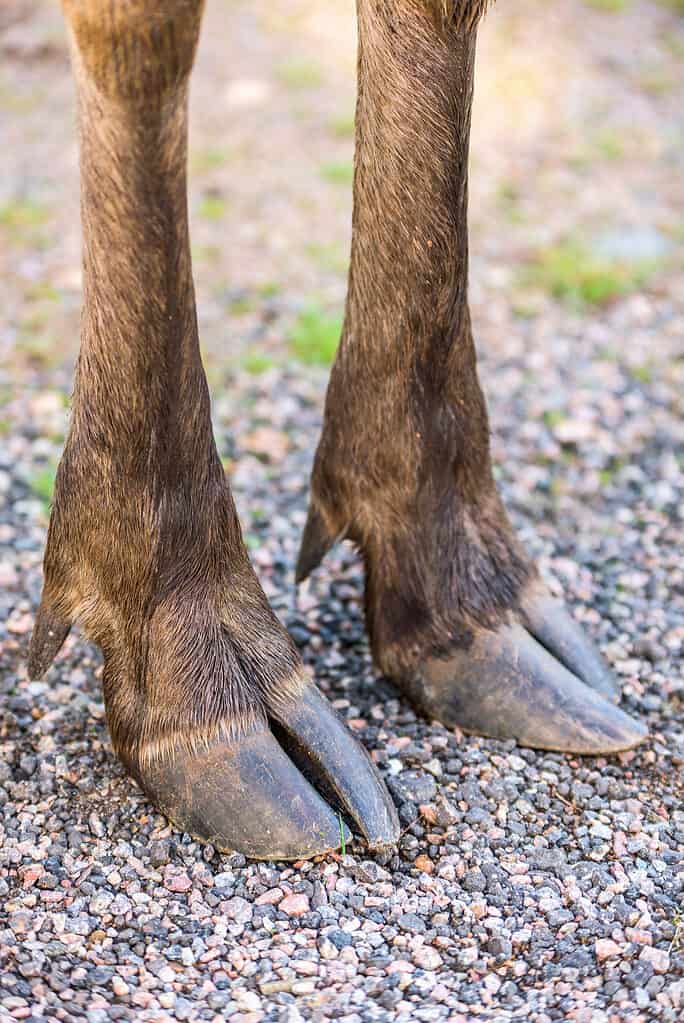
A moose has two hooved toes on each foot.
©Imfoto/Shutterstock.com
Moose tracks are distinguishable from other deer because of their size and shape. Moose are the largest type of deer and have the largest hooves to match. A moose’s track is typically 4 ½ to 7 inches long. They are heart or teardrop shaped with the pointed end towards the front in the direction of travel. Impressions from dewclaws appear as two small dots behind the two hooved toes. Other deer species, like whitetail deer and mule deer, have much smaller tracks than moose. Caribou tracks, however, are somewhat close in size. Despite being much smaller animals, caribou have large hooves that are adapted to walk through deep snow. Their large surface area allow caribou to distribute their weight over a greater area similar to a human wearing snowshoes. Caribou tracks are between 4 and 5 inches long, but they have a distinctly round shape very different from moose tracks.
Snow
When finding moose in the snow, there are a couple variables that will affect your ability to identify their tracks. Although moose have long legs to walk through deep snow, high levels will cause a moose’s foot to drag on the snow’s surface as they take a step, and then sink deeply when their weight shifts. Tracks in very deep snow may therefore be indiscernible. In this scenario, however, contextual clues may help identify the tracks even if you cannot see them clearly. Depending on the geographic location, few long-legged hooved animals capable of walking through high snow will inhabit the area. Local knowledge of population density and coexisting species can help identify tracks that are not easily visible in high snow.
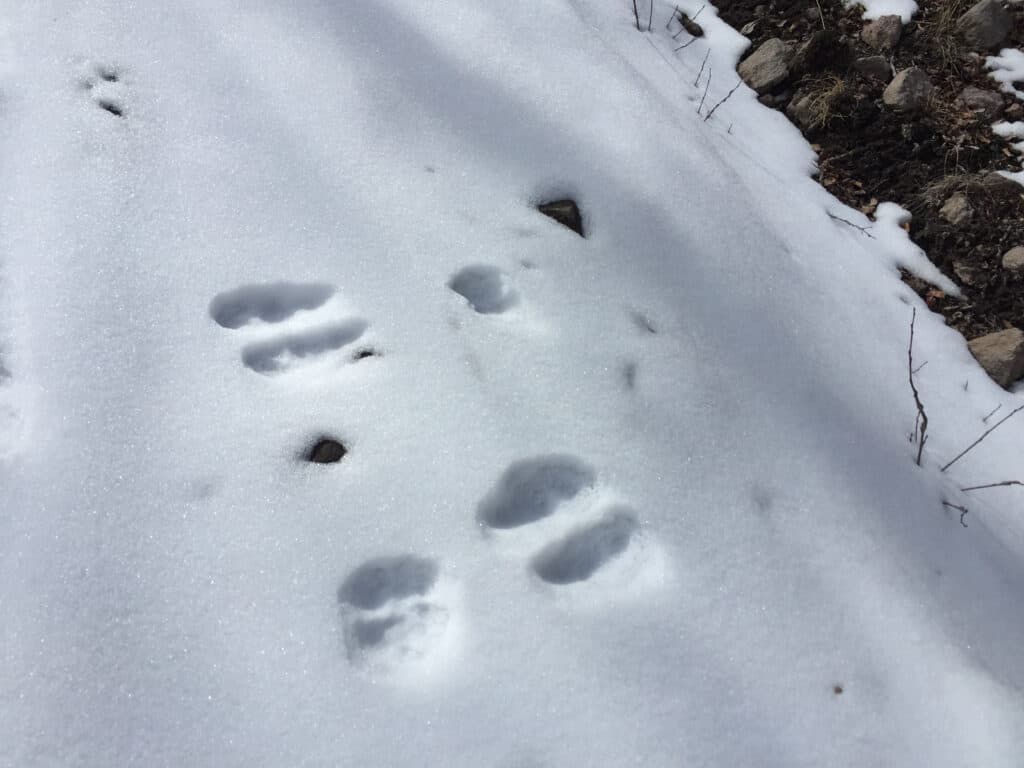
You can see the large hooved toes and the dewclaws in these moose tracks. Compact snow often allows for very clear impressions.
©Bree Reza/Shutterstock.com
In compact or shallow snow, moose prints are often clearly identifiable. Dewclaw impressions may be visible because the cow or bull will sink slightly into the snow, but they may be unclear because of glare or lack of contrast in the white snow. The most identifiable characteristic of moose tracks in the snow will be their notably large size and their teardrop shape.
Mud

The two hooved toes in this moose track are clearly visible in the mud.
©Amelia Martin/Shutterstock.com
In mud or on soft ground, moose of all sizes will likely leave tracks that include dewclaw impressions. With each step, bulls, cows, and calves will sink into the soft ground and leave clear impressions of their two large toes and their vestigial dewclaws. Mud impressions, especially near lakes and other bodies of water, will likely produce the clearest and most easily identifiable tracks. In mud, the teardrop shape of the front toes will be easy to distinguish from round caribou hooves. Size will also be an easy characteristic to identify.
Other Terrain
On hard ground, a bull moose may leave marks from its dewclaws in its footprints, but this is less likely than on soft ground. Cows and calves on hard ground most often do not weigh enough to create a deep impression that includes dewclaws. Also, on hard ground the moose’s toes will not splay like they do on snow or mud. The track will therefore appear narrower on hard ground and the margin between the front toe impressions will be smaller.
Other Tracking Tips
Scat

If you are struggling to identify tracks, other clues like scat may help. Moose scat is larger than other deer and is oval shape.
©Jonathan A. Mauer/Shutterstock.com
When hunting moose or when identifying tracks, an important clue you may find is scat. Moose droppings can be used to identify tracks and determine how recently an animal was in the area. These droppings are often confused with bear or cow scat but there are some distinguishing traits. Moose poop often consists of oval pellets about 1 to 1 ½ inches long. It is visibly different from bear scat which often contains undigested berries. The main factor that separates moose droppings from those of other deer species is their large size. When tracking a moose, how dry or degraded the scat is can indicate how recently the moose was in the area. This is not an exact science, however, because environmental conditions can affect the condition of the excrement.
The photo featured at the top of this post is © iStock.com/RONSAN4D
Thank you for reading! Have some feedback for us? Contact the AZ Animals editorial team.



